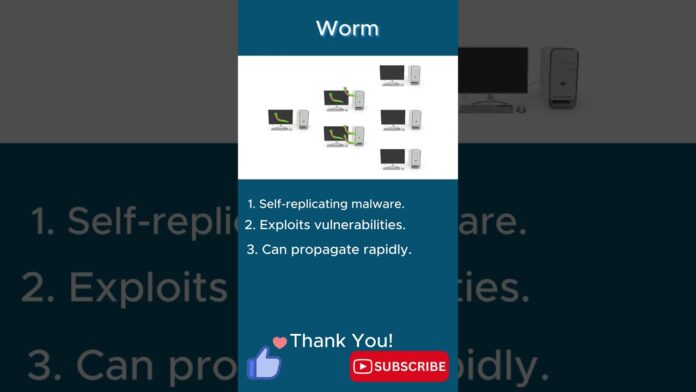In the intricate realm of cybersecurity, worms emerge as a potent and stealthy threat to network integrity and data security. Unlike viruses, which require user interaction to spread, worms possess the ability to self-replicate and propagate autonomously across networks, exploiting vulnerabilities and wreaking havoc on interconnected systems. In this article, we delve into the intricate nature of worms, exploring their characteristics, propagation methods, detection techniques, and strategies for defense.
Understanding Worms:
A computer worm is a type of malware designed to spread rapidly across networks by exploiting vulnerabilities in operating systems, applications, or network protocols. Unlike viruses, worms do not require user interaction to propagate and can spread autonomously from one host to another. Once unleashed, worms can perform a variety of malicious activities, including:
- Network Propagation: Exploiting vulnerabilities in network protocols, services, or software to scan for and infect vulnerable systems within the same network or across the internet.
- Resource Consumption: Consuming network bandwidth, system resources, and computing resources to propagate, replicate, and execute malicious payloads.
- Data Theft: Stealing sensitive information, such as login credentials, financial data, and personal files, for identity theft or financial fraud purposes.
- Botnet Recruitment: Enlisting infected systems into botnets, distributed networks of compromised devices controlled by malicious actors for coordinated cyber attacks or spam campaigns.
Modes of Worm Propagation:
Worms can spread through various vectors, including:
- Network Exploitation: Exploiting vulnerabilities in network protocols or services, such as unpatched software or misconfigured servers, to gain unauthorized access to vulnerable systems.
- Email and Messaging: Using email attachments, links, or messaging platforms to distribute worm payloads to unsuspecting users, leveraging social engineering tactics to trick them into opening malicious content.
- File Sharing Networks: Infecting files shared through peer-to-peer (P2P) or file-sharing networks, exploiting unprotected systems to propagate to new hosts.
- Removable Media: Spreading through infected USB drives, external hard disks, or other removable media containing worm-laden files or executables.
Detecting and Mitigating Worms:
Detecting and mitigating worm threats requires a multi-layered approach to network security, including:
- Network Intrusion Detection Systems (NIDS): Deploying NIDS solutions to monitor network traffic, detect suspicious behavior indicative of worm activity, and block malicious connections.
- Firewalls and Intrusion Prevention Systems (IPS): Implementing firewalls and IPS solutions to inspect and filter incoming and outgoing network traffic, blocking known worm signatures and suspicious payloads.
- Patch Management: Regularly applying security patches and updates to operating systems, applications, and network devices to remediate known vulnerabilities exploited by worms.
- User Education and Awareness: Educating users about the risks of worm threats, phishing scams, and unsafe browsing habits to reduce the likelihood of inadvertently downloading or executing worm-laden files.
Prevention Strategies:
To prevent worm infections and safeguard network integrity, organizations should implement the following preventive measures:
- Network Segmentation: Segmenting network infrastructure into separate zones or VLANs to contain worm infections and prevent lateral movement within the network, limiting the scope of potential damage and data exfiltration.
- Access Control: Implementing least privilege principles and role-based access controls (RBAC) to restrict user permissions and limit access to sensitive data and resources, reducing the risk of worm infiltration and data compromise.
- Email Filtering: Implementing email filtering solutions to block suspicious attachments, links, or content indicative of worm activity, reducing the risk of email-based worm propagation.
- Vulnerability Scanning: Conducting regular vulnerability scans and penetration tests to identify and remediate weaknesses in network infrastructure, reducing the attack surface and minimizing the risk of worm infiltration.
Worms represent a formidable and persistent threat to network security and data privacy, leveraging autonomous propagation and stealthy infiltration tactics to spread rapidly and inflict widespread damage. By understanding the characteristics and behaviors of worms, implementing proactive detection and mitigation measures, and fostering a culture of cybersecurity awareness and vigilance, organizations can effectively mitigate the risks posed by worm threats and safeguard their networks from clandestine intrusions and data breaches. In the dynamic landscape of cybersecurity, resilience, innovation, and collaboration are paramount in the ongoing battle against worms and other emerging cyber threats, ensuring the integrity, confidentiality, and availability of network resources and data assets.
